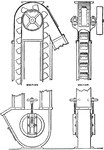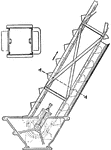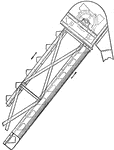Conveyers and Freight Elevators
The Conveyers and Freight Elevators ClipArt gallery presents 22 examples of industrial devices intended to move materials or products horizontally or vertically.

Conveyer Belt
A belt conveyor consists of two or more pulleys, with a continuous loop of material - the conveyor belt…

Dual Pulley Conveyer Belt
A belt conveyor is made up of two or more pulleys, with a continuos belt running through it. One or…
Conveyer Belt
A belt conveyor consists of two or more pulleys, with a continuous loop of material, the conveyor belt…

Spiraling Conveyer Belt
A mechanical apparatus consisting of a continuous moving belt that transports materials or packages…
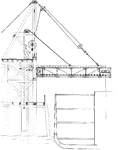
Apron Pan Conveyor
"General arrangement of Apron Conveyor for loading vessels, pans are 48 inches wide, 12 inches pitch,…
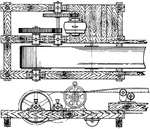
Belt Conveyor
An diagram showing a belt conveyor from the top and side illustrating the arrangement of the drive end.

Four Drum Conveyor
A conveyor system is a common piece of mechanical handling equipment that moves materials from one location…
Lift or Elevator Diagram
A diagram illustrating an elevator or a lift used by Landis Company. The counter weights are adjusted…

Dumb Waiter
An illustration of a dumb waiter which is a moveable frame in a shaft which is suspended by a rope on…
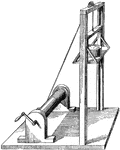
Brick and Mortar Elevator
An illustration of a type of elevator composed of a small pulley used in this case to lift brick and…

Bucket Elevator
A bucket elevator, also called a grain leg, is a mechanism for hauling flowable bulk materials (most…
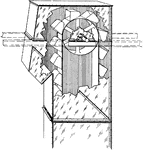
Bucket Elevator
"Drawing showing arrangement of elevator in square steel elevator casing." -Meese, 1913
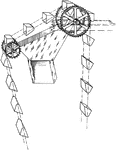
Gravity Discharge Bucket Elevator
"Drawing showing arrangement of "Gravity Discharge" Bucket Elevator." -Meese, 1913

Perfect Discharge Bucket Elevator
"Drawing showing arrangement of "Perfect Discharge" Bucket Elevator." -Meese, 1913

Frue Vanner (Side View)
A Frue Vanner is a shaking, rubber belt used to concentrate gold ore 'pulp'.

Hoisting and Conveying Apparatus
A hoist is a device used for lifting or lowering a load by mans of a drum or lift wheel around which…

